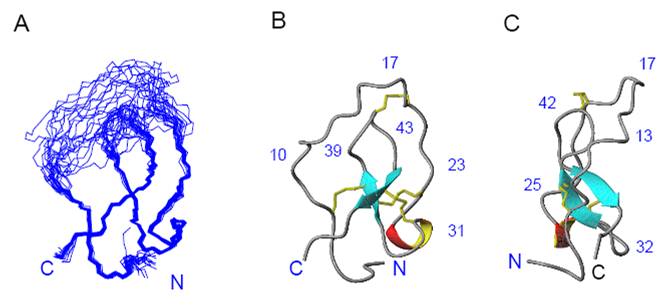|
|
|
|
We
have isolated several new toxins which do not belong to
any of the known families of snake venom toxins. Currently,
we are examining their structure and biological properties.
-
Helveprins : We have purified 15 members
of this family from several snake venoms. This group of
proteins appears to be found in the venoms of all families
of snakes. They are structurally homologous to helothermine,
a toxin isolated from Mexican lizard venom and hence the
name.
-

-
Waprins : We have recently identified
three novel proteins of this family. One of the member,
Omwaprin exhibited antibacterial activity
against gram-positive bacteria. They are homologous to
whey acidic proteins and secretory leukocyte proteinase
inhibitors. We will examine their structure and function.

-
Vespryns : We have completed the amino
acid sequence a toxin, ohanin from King cobra venom. This
is similar to a thaicobrin from Thai cobra. This protein
has a potent hypolocomotory activity. We have completed
its cDNA and gene structure. We are currently studying
its structure-function relationships and mechanism of
action.
- Inflamins:
From
the transcriptome of Aipysurus eydouxii venom gland, we
identified a novel cysteine-rich, secretory protein containing
94 amino acid residues. Recombinantly expressed protein
induced inflammation and writhing in animals, and hence
this protein was named as inflamin. We examined the mechanism
of action of this protein. It induced two waves of prostanoids
production. The first wave peaked at 10 min and 6-keto
PGF1? was the major product. The second wave, specifically
of 6-keto PGF1? and PGE2, started after 2 h. In RAW264.7
cells, COX-1 activity showed a transient increase at 10
min and is responsible for the first wave, but its expression
was unaffected. COX-2 was induced after 3 h and is responsible
for the second wave. Using specific inhibitors, we showed
that cPLA2, and not sPLA2, iPLA2 or DAG lipase, plays
a key role in arachidonate release. The cPLA2 activity
showed a transient increase of 62% at 10 min; this increase
was due to its phosphorylation and not due to an increase
in its expression. Inflamin is the first member of a new
family of snake venom proteins, we named as flamins.

|
Key Publications
|
|

